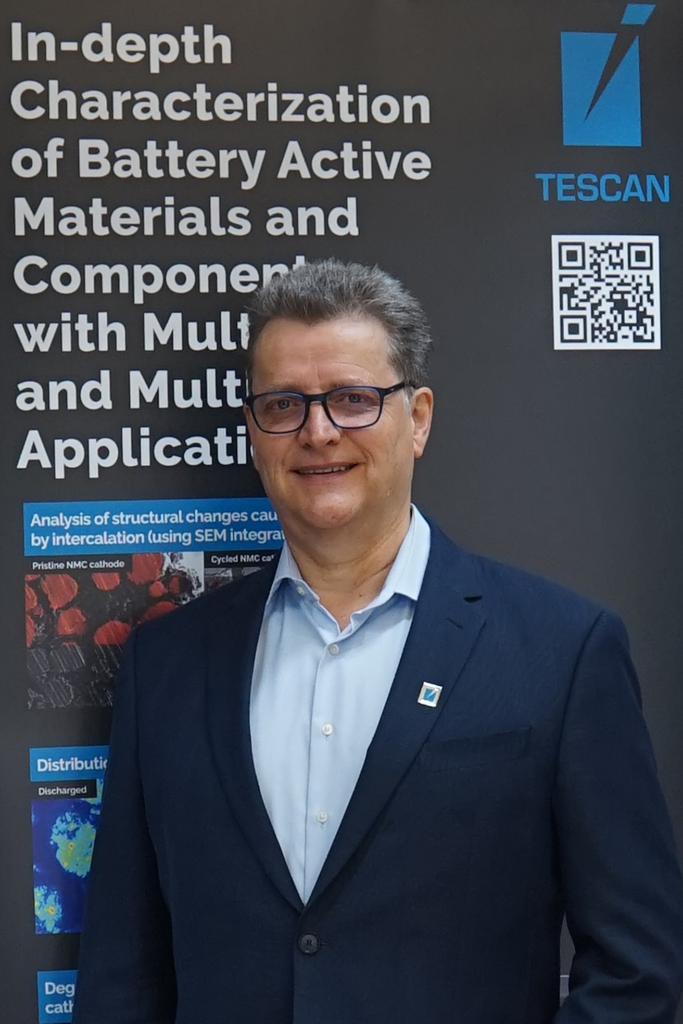We regularly introduce our colleagues across various departments and branches. In doing this, we do not forget the experienced ‘veterans’ who have linked a substantial part of their professional lives with TESCAN. One such person is Berndt Neumann, a key colleague at TESCAN GmbH. What was his first meeting with TESCAN like in 1998, and how did the company captivate him? And how does he envision the future after the acquisition by Carlyle?
Can you share your initial impressions of TESCAN when you first joined EOS 25 years ago? What was the position then of EOS as a distributor?

I joined EOS (Elektronen-Optik-Service GmbH) in Dortmund in November 1998, after being “poached” from my former employer HKL Technology in Denmark (EBSD Systems, which later became part of Oxford Instruments). Along with my colleagues Klaus Weinhold and Thomas Becker I soon joined in the first few discussions with TESCAN. The first face-to-face during the “DGE-Meeting” in September 1999 in Dortmund was actively supported by CamScan and its Managing Director Dick Paden. He introduced us to Jaroslav Klima from TESCAN, who, after a couple of mutual visits to Brno and Dortmund, finally set up the distributorship agreement at the end of 1999.
Although EOS was well established in the German-speaking EM market, selling about 200 CamScan SEMs and servicing an even wider range of instrument brands (MicroSpec, TopCon, Cressington, Cambridge Instruments, etc.), we felt the need to add a modern digital SEM platform to our portfolio, since our existing partners were still facing hardships on their way to digitization.
What motivated you in 1999 to make the transition from being a Camscan distributor to a TESCAN distributor, and what challenges did you face during that transition?
When the cooperation between EOS and TESCAN started, EOS was still actively selling CamScan SEMs as their distributor. At that time the first VEGA with the original small chamber (SB) and PC/Windows-based operation, opened the market for entry-level SEM customers who were looking for a modern, cost-effective SEM-solution. It thus served as a good complementary tool to the Workstation/Unix-based large chamber CamScan SEM, which was still very conservative in the concept on which the hardware and software was based.
When the joint development of the CamScan MV2300 SEM was launched, combining the large CamScan chamber and a suspension frame with VEGA Electron Optics, electronics, and software from TESCAN, it led the way to offer a more comprehensive portfolio of standard SEM with tungsten cathode systems. This strategy resulted in significant sales number within the first 2 years of the cooperation, as we were able to convince some well-established customers to buy a TESCAN system.
Above all, I was always impressed by the innovative power within the steadily growing TESCAN team and the unifying vision of Jaroslav Klima! His deep insight, vision, and perseverance in developing TESCAN to what it is today, impressed me the most and probably it was this that had the most significant impact on my career.
How has your role at TESCAN changed over time, and can you describe your current role?
I have occupied various roles during my time at EOS and TESCAN. I started as sales manager and assistant to the management board of EOS in 1998. When a former partner in the company retired in 2000, I also became an active member in the board of shareholders. I then moved on to be head of sales, authorized signatory, managing director and sales director for TESCAN within EOS.
Given your experience and your expectations from the Camscan to TESCAN transition, what opportunities/chances do you see for TESCAN following the acquisition by Carlyle?
With the acquisition of TESCAN by Carlyle and their investment into the future, I foresee that the innovative power inside TESCAN will gain in strength, leading to new and competitive tools for multi-dimensional analytical solutions, resulting in significant growth of the company over the coming years.
How has the industry and market for microscopy equipment changed during your career, and what trends do you foresee in the years ahead?
The market for microscopy equipment has changed dramatically over the last 25 years – mainly in the speed in which new innovations have emerged, particularly with regard to digitization and software integration. TESCAN was certainly among the driving forces transforming itself from a “newcomer”, into more of a “frontrunner”! We are now often regarded as threat to our more established competitors, as we can see a significant rise in fierce competition and pricing counter attacks.
However, due to the innovative force in TESCAN I can foresee a bright future with both the existing as well as its future product portfolio. Along with new systems and hardware, the trends to be closely followed are certainly further automation based on AI algorithms in control and data processing software, as well as correlative data generation and multi-dimensional processing of data acquired from several different analytical tools.
Can you talk about some of the key attributes or values that you believe have contributed to your long and successful career at TESCAN?
As I have already mentioned, the team spirit which I experienced in Germany, Brno and other TESCAN entities, as well as TESCAN’s innovative power, vision, and perseverance in achieving its goals always motivated me to continue in TESCAN over such a long time. Compared to all other EM vendors – who have tried to poach talented people from our organization – TESCAN is the most flexible and a highly innovative company which always tries to find solutions tailor-made to satisfy the requirements of our customers!
My wish for the future is to keep the team spirit and innovative culture alive within the company and to see the TESCAN brand growing to new heights…


